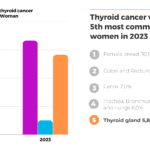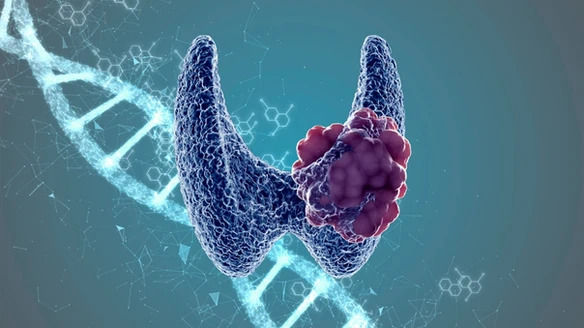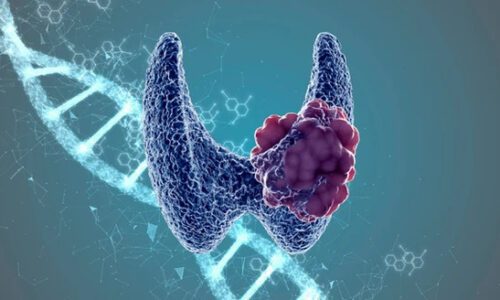- Marcos Santos, Ph.D
- 0 Comments
- 1085 Views
Thyroid nodules are more common than we think. A large portion of the population will find one at some point in life, but fortunately, most thyroid nodules are benign. Due to the high incidence, the treatment for thyroid nodules, whether benign, malignant, or indeterminate, cannot be fixed and linear; it must be adapted to each patient’s case. Learn more about the treatment options in this text.
How is the diagnosis of a thyroid nodule made?
When a thyroid nodule is found, the physician will investigate its nature, whether it is malignant or benign. The first step is imaging tests, which in some situations may not provide a clear determination of whether the nodule is cancer or not. When the nodule is suspicious on the ultrasound, a fine-needle aspiration biopsy (FNA) of the nodule is recommended. In this test, a small sample of cells is obtained from the inside of the nodule for a more detailed analysis (cytological analysis). The analysis of the cells obtained by FNA is classified using an international classification system called the Bethesda System, which ranges from I to VI, as follows:
I – Non-diagnostic sample;
II – Benign;
III – Indeterminate;
IV – Indeterminate;
V – Suspicious for malignancy;
VI – Malignant.
What should be done when FNA indicates that the nodule is indeterminate (Bethesda III or IV)?
In these cases, the mir-THYpe full molecular test is indicated to reduce the doubts that the patient may have when receiving an indeterminate FNA result. The test uses the material from the same FNA that the patient has already collected and reclassifies the indeterminate nodule as “benign” or “malignant”.
Now that you know whether the nodule is benign or malignant, what are the possible treatments?
Benign nodules
- Active surveillance: This is the most common strategy for benign nodules. Although it is not a treatment, the strategy consists of regularly monitoring the patient’s thyroid nodule through thyroid ultrasound, observing if there are any changes in size or ultrasound characteristics. If significant changes occur during this follow-up, the doctor may request additional tests, such as a new FNA or blood tests, to evaluate the nodule’s growth or other changes. It is indicated for all cases of asymptomatic benign nodules, i.e., those that do not cause discomfort in swallowing, breathing, or aesthetic discomfort.
- Ablation: It is a minimally invasive procedure that is being used as an alternative to surgery in patients with symptomatic benign thyroid nodules, i.e., nodules that cause discomfort or dysfunction in swallowing, breathing, or aesthetic discomfort. It is performed using an ultrasound-guided electrode needle, which is inserted into the nodule and then applies heat through radiofrequency or microwaves. This causes the destruction (“burning”) of the nodule’s tissues, reducing its size and possibly being absorbed by the body. It is usually an outpatient procedure, without the need for general anesthesia, and the patient can return home on the same day.
Malignant nodules
- Surgery: It is the main treatment when the thyroid nodule is diagnosed as highly suspicious for cancer or definitively cancer, whether through a biopsy, fine-needle aspiration (FNA), or molecular testing. The two main types of thyroid surgery are:
- Lobectomy (partial thyroidectomy): In this case, the entire thyroid gland is not removed; only the lobe containing the malignant nodule is removed, usually along with the isthmus (the part that connects the two lobes of the thyroid). In this case, the thyroid gland can still preserve its hormonal functions, although there may be some changes in subsequent tests.
- Total thyroidectomy: It represents the complete removal of the thyroid gland. In these cases, the patient will necessarily need lifelong hormone replacement therapy, in addition to possible, although rare, sequelae due to the operation.
For cases of nodules with an indication for surgery (Bethesda V or VI), molecular tests such as mir-THYpe pre-op can help both the patient and the doctor by providing personalized surgery based on the patient’s nodule molecular characteristics.mir-THYpe pre-op analyzes the cells present in the nodule and indicates the presence of molecular markers that can reveal whether the nodule is more or less aggressive, thereby assisting in the medical decision regarding the surgery extention, as follows:
- Patients with malignant nodules but negative molecular markers for aggressiveness may be eligible for partial surgery (lobectomy), for example, increasing the possibilities of preserving thyroid function.
- Nodules with positive markers indicate that it is potentially more aggressive and may require a larger surgical extent (total thyroidectomy and lymph node dissection, for example) and greater surgical urgency.
- Active Surveillance: The majority of thyroid nodules, even malignant ones, do not present aggressive and lethal progression. Therefore, a therapeutic option may be observation to prevent treatment from being worse than the disease itself! It is an approach that aims to actively monitor the malignant nodule without the need for surgical or invasive intervention. It is indicated for nodules smaller than 1 cm. The recommendation for active surveillance should be made by a specialist physician and does not mean “doing nothing.” It means being closely monitored by a multidisciplinary team, with regular follow-up, and intervening at the right time if the nodule shows significant progression. It is an option that also depends on the patient’s acceptance of living with a malignant nodule and even the support network they receive from their family and friends.
- Radioiodine therapy: It is a form of therapy that uses the radioactive element iodine-131 to treat thyroid cancer. This treatment can be used to destroy any remaining thyroid tissue after total thyroidectomy or to treat thyroid cancer cells that have spread to the lymph nodes or other organs. Radioiodine therapy has played an important role in the treatment of differentiated thyroid carcinoma, but it is not indicated for the treatment of anaplastic and medullary thyroid carcinomas. Despite being a therapeutic method that uses radiation, it is a safe and effective procedure.
- Targeted therapy: Although rare, a few malignant nodules will exhibit more aggressive and concerning behavior. When these tumors are resistant to radioiodine therapy, a possible treatment approach is targeted therapy drugs. These are medications designed to target specific molecular pathways or proteins involved in the development or progression of a disease. These drugs work by blocking or inhibiting the activity of specific molecules that play an important role in the disease process. Unlike conventional treatments that affect both healthy and diseased cells, targeted therapy drugs are designed to be more selective, reducing possible side effects.
As you can see, there are various paths that a patient with a thyroid nodule may follow during their journey. This text is for informational purposes, and the determination of the best treatment for each case will be made by the doctor in collaboration with the patient. Onkos is here to assist in this process; follow our Instagram for this and other content about the thyroid.
References:
- American Thyroid Association – https://www.thyroid.org/thyroid-cancer/ The 2017 Bethesda System for Reporting Thyroid Cytopathology
- Thyroid- https://www.liebertpub.com/doi/full/10.1089/thy.2017.0500
- https://www.cancer.org/cancer/thyroid-cancer/treating/radioactive-iodine.html
- http://www.oncoguia.org.br/conteudo/iodoterapia-para-cancer-de-tireoide/1887/236/
- https://www.santapaula.com.br/blog/iodoterapia-no-tratamento-oncologico-o-que-e






